The Army, the Navy, the Air Force, and the Marines
(Not so) Strategic Bombing – the Arc Lights
The Air Force had B-52 bombers dropping either 500 lb. or 750 lb. high explosive (TNT) ‘iron’ bombs. B-52 missions were launched out of country – Guam and Thailand the most likely bases. Probably very boring missions for the aircrews – long transit times to and from the target area with only a few minutes of target ‘line-up and drop’ from very high altitudes while following a straight-line compass heading. Never seeing the ground, never sighting the target. There was much noise and explosions.
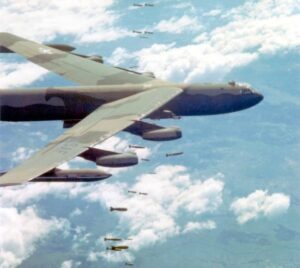
For all the bombs ferocity an NVA or VC in a fortified ‘spider hole’ often survived these massive bombings. Always best to keep the aircraft UHF radio tuned to the universal UHF ‘guard’ radio frequency to monitor any special alert broadcast notices advising dangerous munitions releases and their tactical air nav locations.
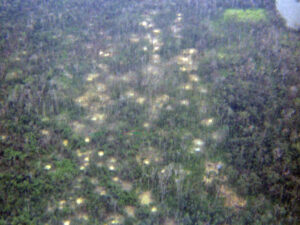
The ’arc light’ patterns always followed a straight-line narrow corridor – you could watch the progression of explosions as the bombs detonated on ground impact. The reality of this bombing was twofold: 1) lots of wasted munitions, and 2) lots of decimated jungle. A waste of military men, machines, and munitions. For those caught near the target zones – hearing loss and brain concussions.
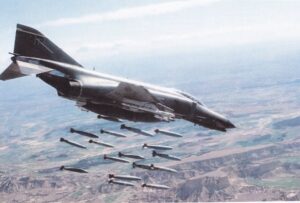
The Marines flew the A-4 Skyhawk and F-4 Phantom jets from MAG (Marine Air Group) bases inside Vietnam. The Skyhawks were used as low-level close air support fighters – the Phantoms more precise bombing. The Skyhawks employed snake and nape (TNT and/or napalm) for close in, low altitude strafing. The Phantoms flew parabolic curved bombing profiles. Their 500 or 70 lb. iron bombs were armed with ‘high drag’ fins permitting a slow drift to target while escaping the targeted area. The fighter crews were called zoomies referring to their high-speed, high-performance aircraft.
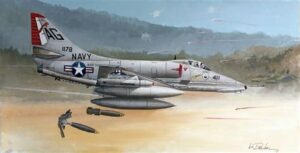
Marine and Naval helicopter gunships were rare commodities compared to US Army Cobras and UH-1C Charlie model helicopters. The Cobra gunship was only flown by US Army units and in mid to late wartime missions (1967-1971). The UH-1 USMC/Naval gunship versions were equipped with a General Electric turbine engine, similar 2.75” rocket systems, but very heavy and bulky steel gun mounts for the M-60 machine gunners. These mounts had very restrictive fields of fire – the M-60 range of motion was extremely limited whereas Army gunners would use either a suspended bungee cord or ‘hand-held’ free guns. The hand-held ‘60s allowed movement and shooting outside the aircraft – virtually unrestricted movement only limited by the skill and boldness of the gunner willing to ‘step out into space’ and blast away!
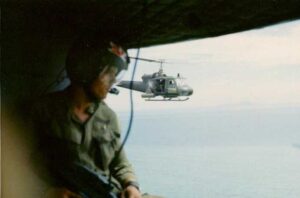
In Hollywood movies when a guy gets greased with a machine gun, he simply grunts a few times and then crumbles to the ground like a wet dishrag. In real life when someone gets hit with a burst of 7.62 from an M-60 machine gun, the recipient gets blown backward several feet. Not to mention that some of his ‘insides’ immediately become ‘outsides’. The amount of kinetic energy will literally knock someone heels first over the victim’s head. Although classified as ‘small arms’ – an M-60 burst is absolutely devastating. Blood and bones splattered far & wide. The human impact is extremely overwhelming. As the Joker remarked in the 1989 Batman movie, ‘I was there, I saw it!’
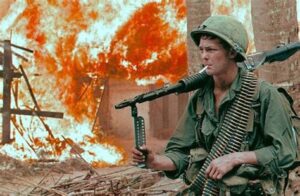
American grunts called their M-60 the ‘Pig’ while helicopter door gunners referred to it as the ’60. Either way, it was a devastating weapon.
The common rocketry employed by all the helicopter gunships in Vietnam was the 2.75” FFAR (folding fin aerial rocket). Tube launched and electrically fired. It had the same accuracy as Kentucky windage – which was not pin-point accurate. Sometimes lucky, sometimes not as the folding fins when deployed would seek ‘relative wind’ – sometimes straight, sometimes curving, sometimes crossing, but usually striking in the general targeted area.
Several choices were available to the armed aviators – HE (high explosive TNT) in both the 10 lb. and 17 lb. variety warhead. White phosphorus or ‘willy pete’ that created white hot fire and smoke – great for burning and marking targets. Colored smoke rockets were seldom used – a discharged aerial smoke cloud was almost useless. The Flechette rocket was a deadly and dreaded weapon against soft targets – aka human flesh. So deadly, their use was eventually discontinued for humanitarian reasons (even in a war?). The rocket contained 4600 aerodynamically shaped & sharpened steel darts that, when dispersed, traveled with near supersonic impact. Enemy soldiers were found nailed against a targeted backdrop.
Firebirds gunships had several configurations – basic Hog was two – 19 shot rocket pods,
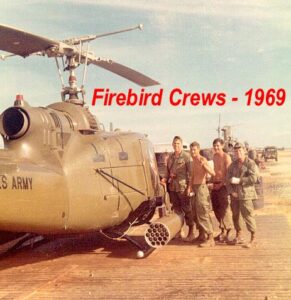
Frog was the Hog plus a 40 mm nose mounted turret,
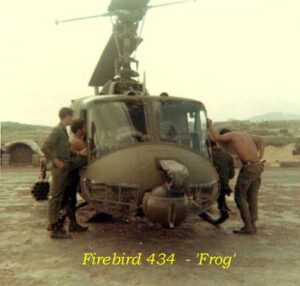
the ‘mini-gun’ ship with 2 seven shot rocket pods plus the 7.62 electrically fired, six-barreled gun on both sides of the helicopter.
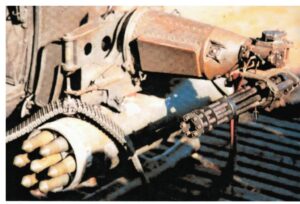
All configurations carried two door gunners sporting the ubiquitous M-60 machine gun carried ‘hands free’.
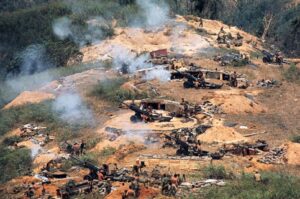
Other American weapons were the 105mm and 155mm artillery guns used to blast holes in the jungles and rice paddies. Most guns were located on fire support bases (FSB) and provided targeted high explosive rounds or nighttime area illumination. Fire missions could be directed to specific areas or used as H&I (harassment and interdiction) – nothing specific, just raising hell in general and only at night. Impossible to sleep during a 155 barrage, 105 is OK, though.
A technologically inferior ground force carried the AK-47 automatic rifle that fired a 7.62 x 39 mm round versus the American M-16 automatic rifle that fired the NATO 5.56 x 45mm round. Although the M-16 had a longer effective firing range, the AK-47 was more rugged and reliable in the jungle combat zone. The AK could be dropped in water or mud – it would continue to operate. The M-16 required almost constant maintenance and lubrication. Score 1 for the bad guys.
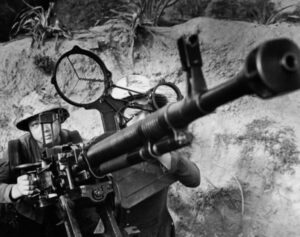
To combat the aerial menaces, the VC employed the Russian NSV 12.7 mm (.51 cal.) gun used against helicopter targets. Very effective at low altitude and low aircraft speeds. There were also larger weapons used such as the Russian ZSU-23, 37mm, and 85 mm anti-aircraft guns. These guns were used against the American ‘fast movers’ – the Air Force and Navy/Marines Phantom jets – and were surprisingly effective when hits were scored against the aircraft.
The SAMs (surface to air missiles) shot down many of the aircraft invading the North Vietnam airspaces. Described as ‘flying telephone poles’, most aircraft sustained destructive and, in some cases, nonsurvivable hits. Catastrophic damage to the aircraft, crewmen inflicted with life threatening wounds, and in then captured and held as hostages for the duration of the war.
Punji stakes, booby trapped souvenirs, bouncing Bettys, snake infested tunnels – all unsophisticated, yet effective weapons used by the technologically non-advanced VC and NVA.
The Night
Nighttime was another useful enemy weapon – Americans hated fighting in the night. American field units would create nighttime defensive positions called laagers. Digging in, camouflage, cans of cold C-rations, maybe the sky or maybe the rain as a tent. Nighttime perimeter guard duty – the bad guys liked night ambushes of hunkered down sleeping soldiers.
American commanders eventually brought their field units into semi-fortified positions at night. ‘Inside the wire’ was better than outside in the bush. The night belonged to the bad guys. The Night is a great weapon for those afraid.
(c) Copyright – 2023 Vic Bandini